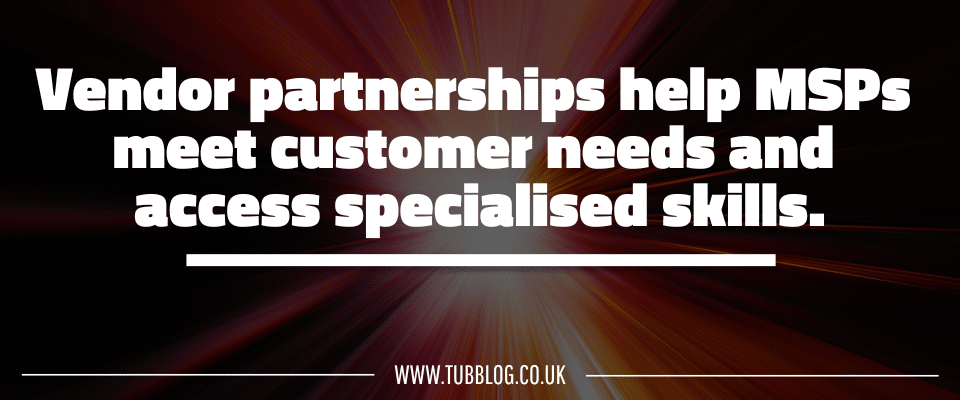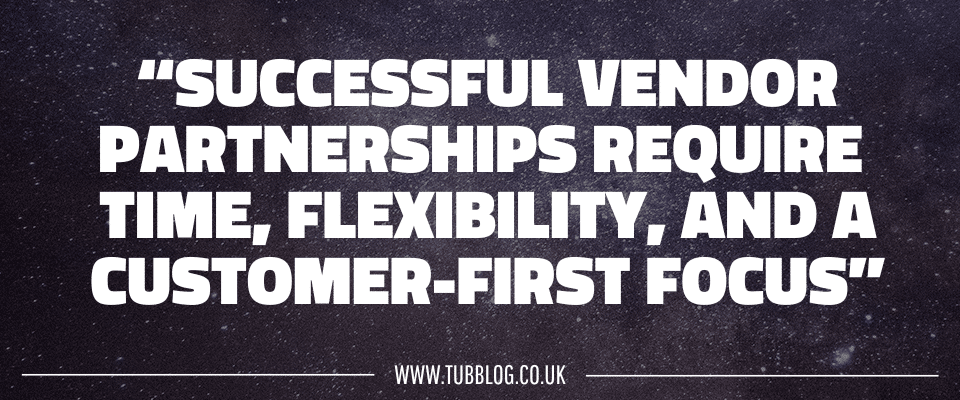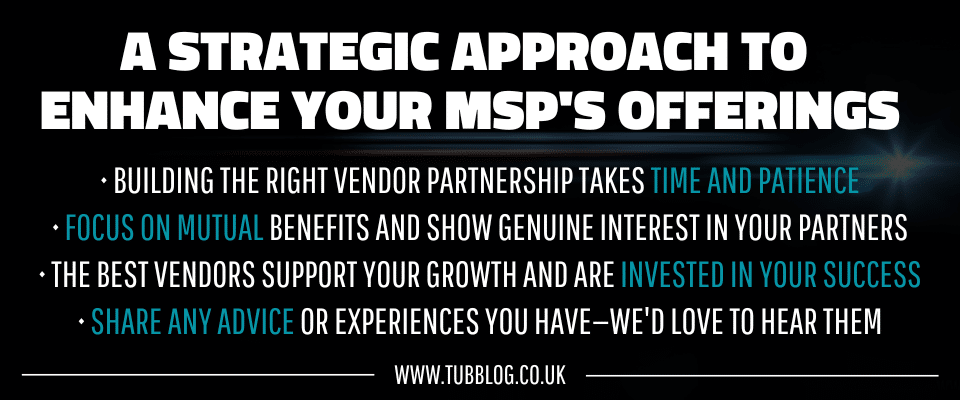Over time, it’s reasonable to expect that what you offer your customers is likely to change. That doesn’t necessarily mean your audience changes. But the technology you or they use might evolve rapidly as you work together. So partnering with vendors might be helpful.
What’s more, it’s not always reasonable for you to expect to handle and process absolutely everything you offer in-house. As an MSP, you likely work with a variety of different tools and services to offer packages to customers. And good vendor relationships can help with that.
Vendor partnerships can help enhance the packages and services you offer customers, whether by making things more convenient or introducing completely new features. Therefore, by partnering with the right vendors, you could take advantage of some serious growth – boosting your bottom line, brand awareness, and customer loyalty.
But how should you approach partnering with vendors, and what are the longer-term benefits of bringing external support on board?
In this guide, I’ll take you through how to improve your MSP’s offerings with the help of carefully-selected vendors and their specific solutions. Whether you’re just starting out with an MSP or are a few years into your journey, there’s never a bad time to consider taking on a new partner or two!
What Does Partnering With Vendors Mean?
Partnering with vendors simply means that you set up contracts with external firms to support the packages you offer to customers.
For example, let’s say that the managed service you offer to customers includes malware and cybersecurity coverage.
Instead of handling the finer points of security in-house, you might partner with a cybersecurity software provider – like Huntress, for example. So you offer round-the-clock support, firewall services, and malware protection.
Or, you could work with a cloud management platform to provide customers with access to a range of off-site services. Alternatively, you might work with a vendor to set up a responsive technical support service.
Regardless, partnering with vendors ensures that MSPs can continue to meet the evolving demands of their customers, and that they have access to extended skill sets they can rely on in a pinch.
Beyond simple partnerships and work sharing, there’s also the phenomenon of the strategic partnership. As business development expert Greg Jones discusses with Richard via TubbTalk, this is a connection you make to foster growth. It’s not just to get products and services.
Jones rightly points out that building long-lasting relationships between vendors and MSPs is extremely important. With the right vendors, you can grow your MSP as a collective – and maintain mutually beneficial relationships over time.
Therefore, even if you don’t foresee offering any specific new services or product upgrades in the near future, creating vendor partnerships could be conducive to creating a healthy support network you can fall back on as and when you need it.
But what are some of the further benefits of working with the right tech vendors?
Benefits of Partnering With Vendors for Tech Tool Support
As mentioned, setting up a flexible, friendly support network is just one key reason why it’s worth seeking vendor relationships.
Here are a few other points to consider. They’re helpful wherever you are in your growth journey. And it applies to all products and services you currently offer:
It’s Easier to Keep up with Evolving Customer Needs
Your customers’ needs are, naturally, going to change over time – and that’s not always going to be something that’s easy to predict.
For example, the rise in automation and AI over the past few years has caught a few companies off-guard – with some needing to scramble to offer generative services and automated support to help boost customer satisfaction.
By partnering with specialist vendors, you always have fingers on various pulses. You have access to experts who can help you adapt to new needs as and when they arise.
And that means there’s little need for you to relearn things or spend time training your own teams.
You can Attract More Customers with Additional Solutions
Depending on the services you offer to customers, there may still be plenty of scope for you to add additional products and enhancements.
It’s also reasonable to expect not knowing how to do everything from the get-go. For example, you might find that there are a few cybersecurity features and services you could offer to bring in more customers.
You might discover that there’s a burgeoning demand for penetration testing and vulnerability scanning, alongside general firewall and network security management.
Instead of training or upskilling on this in-house, you could find a vendor to manage that type of security testing for you. And that could prove be cost-effective
Now – just how cost-effective vendor partnerships could be depends somewhat on the people you work with. And how often you use their services. You’ll need to tread carefully when it comes to determining whether or not prospective relationships will be genuinely valuable to you.
Regardless, there are cost savings available from the get-go if you hire, say, a vendor to handle projects and services you don’t offer outright to customers.
As you can save money on hiring and training people by outsourcing certain work, you can do so on bringing in experts by simply offloading or white-labeling certain cases to your vendors.
You have instant access to expertise, meaning there’s no need to invest in expensive training or hiring people to temporarily handle vital projects.
Having a vendor on standby means there’s always someone in your support network or pipeline who can pick up a specialist demand.
Partnering With Vendors Keeps you Competitive
Keeping track of the competition is healthy. After all, it pays to see what other MSPs offer in terms of USPs, and why certain customers use them rather than you. It’s nothing personal against you!
One of the best ways to stay competitive is to bolster your service arsenal with expertise and tools that grow with your customer demands.
Consider the difference between a vendor-free MSP and one with several partnerships. Unless the former offers a broad range of skills and services that really set themselves apart from the pack, the latter will likely win out because they have more expertise and resources to pool.
Again, the more expertise you have by your side, the more flexible you become. An MSP with vendor partnerships will often be able to pivot faster in the event of major industry or demand changes compared to one that’s solely reliant on in-house talent.
That’s not to devalue the people you employ – rather, that a company with multiple strings to its bow is likely to be more capable and therefore appealing compared to one with little support.
Conversely, less is sometimes more when it comes to the number of partnerships you have in place. Experienced MSP owner and advisor Eamon Moore suggests, for example, that working with a handful of vendors could help you give back clarity to your customers.
Customer Support is More Efficient
When you’re approached with a problem or a project request, you’ll typically advise your customer of timescales by which you can return to them.
When you work with vendors, you share and delegate this workload. You could bring on board software development experts, for example, if your customer has a highly specific demand of your suite or resources, but you can only get back to them with a solution by the end of the month.
When you have vendor knowledge to pool from and people to delegate to, you can serve and support your customers faster. Everybody wins!
It’s Easier to Train up Your Team on New Skills and Software
You don’t have to delegate everything to vendors. In fact, you should be spending time upskilling your team on gaps that are proving to be sticking points when communicating with customers.
For example, let’s look again at AI. More and more people want to harness the cost- and time-saving benefits of machine learning. If your MSP can’t support its customers due to a lack of knowledge or experience, you can partner with vendors to offer both.
Consider it direct access to experts who can not only help you grow and enhance your services, but who can also improve your team’s capabilities and skillset.
You Could Boost Brand Recognition and Sales
Publicly partnering with leading software vendors and highly-rated specialists in their industries could have a fantastic knock-on effect for your own bottom line.
Successful vendors don’t enter into partnerships lightly, meaning a strong relationship with a well-known brand could inspire more customers to invest in your services.
However, it’s never wise to seek out vendor partnerships purely for the endorsement potential. If anything, this effect is secondary to the benefits I’ve explored above.
But it’s a powerful benefit nonetheless! What are some examples of technology vendors you could partner with?
If you’re mulling over the benefits of working with a technology vendor or two but are unsure of which direction to move in, let’s take a look at a few examples.
The following are all expert tech vendors we’ve highlighted here at Tubblog who offer specialist services to MSPs looking to grow and evolve:
- Keepabl, a B2B solution that helps growing companies manage complex data compliance demands
- Uptime, a multi-faceted vendor that aids MSPs with operational support, ad-hoc project delegation, and 24/7 helpdesking
- Hornetsecurity, cloud security experts who offer a range of infrastructure protection solutions alongside cybersecurity awareness training
- Huntress, experts in real-time protection, endpoint guarding, and off-site security operations management
- SuperOps, a scalable professional services automation (PSA) provider, simplifying AI and automated processes for growing businesses
How do You Set up Successful Vendor Partnerships?
While it’s entirely possible to start benefiting from partnering with vendors right away, it is going to take time for you to build lasting, truly beneficial relationships.
What’s more, there is never any guarantee that the vendors you initially choose will be right for you. Unfortunately, this part of your journey in running an MSP will always come with some trial and error.
Therefore, the best thing you can do before seeking out successful vendor partnerships is to foster an open mind. Be willing to test the waters with potential partners and be careful with contracts.
And create a flexible and forgiving action plan. If you have to double back and try new avenues, so be it.
Here are a few tips to keep in mind when getting started looking for vendors to partner with, and how to stay resilient in the face of careful long-term relationship building.
1. Have a Plan in Mind (and Keep Your Customers at the Heart of Everything)
The key to planning ahead with vendors is to focus on your customers first. You should ideally be entering into vendor relationships to improve your service offerings rather than to increase your prestige.
So, like with any good business plan, take stock of where you are now. What services and products does your MSP offer? Which are the most popular? Are there any areas that your customers have requested particular support with that you could grow into?
Think carefully about where you want to be in several years’ time. Do you want to niche down into a particular type of product, or do you intend to cover a broad range of services?
Your answers here will help you narrow down the types of vendors to look for – and to establish what you will value the most from support.
It’s also worth asking vendors about some of these areas, too – what do their roadmaps look like? What’s their attitude toward growth – and how can they help you scale up?
2. Create a Comparison Checklist
Just like comparing any product or service, it makes sense to have a list of essential features and services that you need your vendor to provide.
Once you have a roadmap of sorts in place and know what you want to niche down or expand into, create a checklist you can apply to each vendor you come across and investigate.
For example, regardless of the services you’re looking for, you could compare vendors on:
- How easily they could integrate with your existing services
- What specific support they offer to MSPs
- The security standards they have in place
- Their standing in their industry and level of expertise
- Opening packages
- Support they have available and the channels they work through
- Contract lengths
I’ll cover some of these areas in a little more detail below, but to start, it pays to have a shopping list of sorts so you’re not simply entering into a partnership for the sake of it.
3. Pay Attention to Reviews and Testimonials
Naturally, a leading vendor is going to be proud of its five-star reviews, and these shouldn’t be too difficult to see from their web presences.
However, go beyond the basic sales patter and social proof. Dive deep into what others have to say about a specific vendor. Start by looking into honest Google reviews, searching for their mentions on LinkedIn and Reddit. And, where possible, look for insight from other MSP clients.
Be prepared to push Google to the limit when researching potential vendors. Just because they have a strong set of client reviews on their website doesn’t always mean they will be the right fit for what you need.
Pay attention to specific reviews written by people with genuine experience of working with your prospective vendors. On a positive note, you might uncover something interesting about them that makes you want to pursue a relationship even more.
4. Look Carefully into MSP Offerings
This is a point I mentioned briefly above, but it certainly deserves its own focus. You need to find a vendor relationship where there are clear boundaries and it’s obvious what both parties get from a partnership in the long run.
For example, ask your potential vendors to explain how it offers resources and to what extent. What does it have specifically to offer MSPs – is it purely ad-hoc expertise, or can it train your personnel, troo?
What is your vendor’s stance on feedback? Does it have open channels or even an advisory board? The presence of the latter could suggest that it is particularly welcoming to two-way feedback.
Ultimately, you want to be clear on what to expect as the MSP in a vendor’s partner program. If representatives can’t give you clear answers or any kind of structure, it might be worth looking elsewhere.
That means being clear on contracts, too. Are your vendors flexible? What is a minimum term for your potential partner, and are there any deal-breaking policies?
5. Prioritise Budget Compatibility
Finding vendors you can afford is a given. However, it also pays to look for companies and services that can work to your expected budget over the months and years to come.
Discuss the support that a vendor could offer you based on your projected budget allocations. Look carefully at the genuine value you claim back from investing in vendors, too.
Do the services they offer provide enough of a return on your investment for sustainable long-term partnerships?
You should also consider doing some homework on your vendors’ financial health. Dig deep into their operational histories – and ask them directly about their financial performance.
6. Test Drive What Vendors Have to Offer
Let’s say you want to work with a CRM software provider who can help streamline your customer journeys and improve your own client relationships. In this scenario, you’d be well within your rights to ask for a trial run of the software you’re about to put capital behind.
Many vendors offer free trials and hands-on explorations of what they have to offer. However, if this isn’t forthcoming at first, don’t assume it’s a red flag. Ask if you can see platforms and products working in a live demo, if not, try to explore products hands-on yourself.
Not sure what a CRM is? This article might help.
7. Take Time to Cultivate Your Vendor Relationships
Once you’ve set up with a vendor, don’t set and leave the partnership idle or only refer to them when you need them.
The best vendor partnerships are built on clear communication and mutual respect. That can mean taking the time to get to know people at various areas of their business, involving their teams and decision makers in important events, and generally networking.
You might even find further mutual benefits from working together – which will help to cement your relationship for time to come.
Ultimately, the best vendor relationships aren’t purely transactional. Instead, they should be about sharing knowledge and experience and supporting each other, not just paying for a service.
In Summary
Finding the perfect vendor partnership or relationship isn’t going to be something you accomplish overnight. And, the advice I’ve given above might not always fit your specific needs or circumstances.
The best advice we can all give here at Tubblog, however, is to show genuine interest in anyone you work with – and to focus on building mutual benefits and respect over time.
The best vendors you work with will have your back when you need them, and will be genuinely invested in helping you grow your MSP. If you have any specific advice or guidance of your own that you’d like to share, please let us know!


















Comments